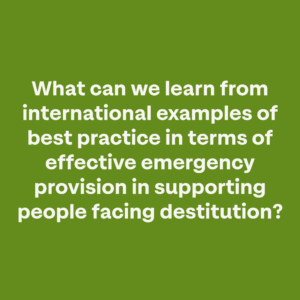
Feeding Liverpool recently submitted three submissions to the All-Party Parliamentary Group inquiry into ending the need for foodbanks. A wide range of opinions have been offered about the best way forward for ending the need for foodbanks – this work will form the foundations for a wider review of our city’s crisis response.
This series of blogs is taken from the Good Food Community Advocacy and Policy Group submission.
What can we learn from international examples of best practice in terms of effective emergency provision in supporting people facing destitution?
By Ellen Schwaller, PHD candidate at the University of Liverpool and member of the Good Food Community Advocacy and Policy Group
Food insecurity is rooted in long-term social inequalities. Household income alone is the strongest predictor of being at-risk for experiencing food insecurity[1]. Centring this issue as a symptom of deeper and complex issues is key to understanding the role of various interventions to address both long- and short-term food insecurity. Community-based, food assistance programmes, while important to alleviate temporary food insecurity, are not viable long-term solutions[2] and in some cases were not successful in reaching all food insecure households experiencing additional crises during the COVID 19 pandemic.[3] Fiscal policies supporting families such as targeted cash-transfers lead to better food security outcomes,[4] and further evidence supports shifting to more comprehensive, population-based fiscal solutions (e.g. a modified universal-basic income and increases to minimum wage) for better outcomes.[5]
Here, examples of targeted (food-based) fiscal interventions from the United States are briefly summarised and examined. Outside of in-kind food provision, interventions in developed countries are split into two approaches: subsidies and income or cash-transfers. These are often aimed at the household or individual experiencing food insecurity. One of the most wide-reaching cash-transfer policies in the US is the Supplemental Nutrition Assistance Program (SNAP). While it is generally considered effective in improving food security for the most disadvantaged, it has been criticised for a number of reasons (e.g., as an entitlement programme there are stigma and barriers to access and gaps for ineligible households experiencing food insecurity).
This well-established and far-reaching programme provides a platform to adapt to address additional needs and leverage for other interventions. During the COVID 19 pandemic this was achieved through top ups to funding and was successful at preventing food insecurity.[6] Equally, other interventions (e.g. food financing initiatives) can be combined with SNAP to further improve access to healthy foods.[7] Nationally, double dollar programmes for fresh produce at farmers markets are also leveraged to increase access to fruits and vegetables and simultaneously support the local food system.
Less far-reaching but important to consider is the Gus Schumacher Nutrition Incentive Program within the USDA. It supports nutrition incentive (NI) programmes, produce prescription programmes, and related training. A recent report demonstrated a two dollar return for every one dollar spent to the local food retail economy along with sustained nutritional benefits and reduced food insecurity to participants in the funded interventions.[8] The report includes additional details and outcomes of a two-year period of funding for 30 programmes across the US The breadth of NI programmes funded demonstrate promising local and community-driven models to improve food security and nutrition while supporting the local economy and food system (e.g., doubling dollars at local farmers’ markets, subsidising community supported agriculture shares). It also highlights programmes that support both accessibility and availability of healthy food (e.g., mobile markets).
This type of initiative marries community-based knowledge of local systems and needs with the necessary infrastructure and support from larger government funding; however, the temporary nature of this grant-making process is cause for concern and must be combined with long-term efforts to address root causes of food insecurity. Leaning on community-based efforts and charities rather than comprehensive reform is a dangerous approach especially when faced with extreme shocks. Ensuring more permanent, government-based structures need to be in-place to support households at risk of and those already experiencing food insecurity.
[1] Gundersen C, Kreider B, Pepper J. The economics of food insecurity in the United States. Appl Econ Perspect Policy. 2011;33(3); Leete L, Bania N. The effect of income shocks on food insufficiency. Rev Econ Househ. 2010;8(4); Sriram U, Tarasuk V. Economic Predictors of Household Food Insecurity in Canadian Metropolitan Areas. J Hunger Environ Nutr. 2016;11(1).
[2] Loopstra R. Interventions to address household food insecurity in high-income countries. Proc Nutr Soc. 2018;77(3):270–81.
[3] Men F, Tarasuk V. Food insecurity amid the COVID-19 pandemic: Food charity, government assistance and employment. Can Public Policy. 2021;COVID-19(April 2020).
[4] Ionescu-Ittu R, Glymour MM, Kaufman JS. A difference-in-differences approach to estimate the effect of income-supplementation on food insecurity. Prev Med (Baltim) [Internet]. 2015;70:108–16. Available from: http://dx.doi.org/10.1016/j.ypmed.2014.11.017
[5] Gundersen C. Viewpoint: A proposal to reconstruct the Supplemental Nutrition Assistance Program (SNAP) into a universal basic income program for food. Food Policy [Internet]. 2021;101(April):102096. Available from: https://doi.org/10.1016/j.foodpol.2021.102096; Men F, Urquia ML, Tarasuk V. The role of provincial social policies and economic environments in shaping food insecurity among Canadian families with children. Prev Med (Baltim) [Internet]. 2021;148(October 2020):106558. Available from: https://doi.org/10.1016/j.ypmed.2021.106558
[6] Bryant A, Follett L. Hunger relief: A natural experiment from additional SNAP benefits during the COVID-19 pandemic. Lancet Reg Heal – Am [Internet]. 2022;10:100224. Available from: https://doi.org/10.1016/j.lana.2022.100224
[7] Cantor J, Beckman R, Collins RL, Dastidar MG, Richardson AS, Dubowitz T. SNAP participants improved food security and diet after a full-service supermarket opened in an urban food desert. Health Aff. 2020;39(8).
[8] Gretchen Swanson Center for Nutrition. Gus Schumacher Nutrition Incentive Program Training, Technical Assistance, Evaluation, and Information Center (GusNIP NTAE): Impact Findings [Internet]. 2021. Available from: https://www.nutritionincentivehub.org/media/fjohmr2n/gusnip-ntae-impact-findings-year-2.pdf
